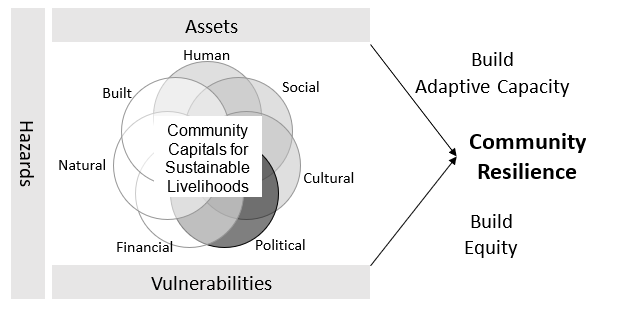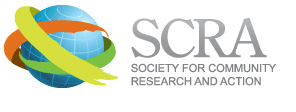Submitted by: Anne Cafer
Highlights
We now have a tool for making comparisons of very context specific issues across spaces.
────
The Community Resilience Framework is grounded in practical application and can be the starting point for systemic assessment of resilience building efforts at the community level.
────
The Community Resilience Framework is grounded in practical application and can be the starting point for systemic assessment of resilience building efforts at the community level.
The Community Resilience Framework (Figure 1.) was developed with a particular emphasis on community development practice. Two potential methodologies can be paired with the framework to engage communities, inform policy, and build resilience.
We combined the Sustainable Livelihoods Approach and Community Capitals Framework to address four critical concerns in the current community resilience literature. One concern is the need for greater flexibility to account for the wide variety of actors within a community system. A second concern––the dominance of only four major outcomes (nutrition security, food security, environmental sustainability, and economic security)––ignores other important system-level capacities.
The Sustainable Livelihoods Approach analyzes how the lives of people with low socioeconomic status and other disadvantages change over time. This approach recognizes that all people have abilities and assets that can be developed to help them improve their lives.
The Community Capitals Framework is a model that views assets of a community as well as deficits that keep communities from full health. There are seven community capitals:
- Natural Capital—including resources and natural beauty
- Cultural Capital—including comfort and collaboration with racial, ethnic, and age-related diversity
- Human Capital—including citizens’ skills and abilities and access outside resources and knowledge
- Social Capital—including the extent to which citizens within communities are connected
- Political Capital—including influence over standards, rules, regulations and their enforcement
- Financial Capital—including the financial ability to invest in capacity building within the community
- Built Capital—including infrastructure like parks, roads, and telecommunications systems.
How Did A Community Psychology Perspective Inform Your Understanding of the Issues, Results, and Implications?
Understanding the role of community systems on individual levels of apathy, sense of inclusion, and motivation for community-wide improvement was critical to the development of this model. We know that getting stakeholder input is essential to the work of community development practitioners and community members need to feel like all of their needs are being addressed–not just flood prevention or hurricane mitigation. A broader sense of well-being is critical to long-term buy-in from community members and this model helps practitioners do this.
The literature is oversimplistic without recognizing that resilience is not experienced equally across all socio-economic or demographic groups. Resilience building, if it doesn’t account for these differences, can be mal-adaptive for poor or marginalized communities. A final concern is overemphasis on specific resilience (resilience in light of a specific disaster—hurricane, flood, tornado, mass shooting) rather than general resilience. This research synthesizes two key community development approaches in a way that provides a practical method of assessing community resilience and building strategies among practitioners. The integration of multiple systems and multiple capitals is critical to sustainable community resilience building. This approach was also designed to be of practical use, not just theoretical, so that practitioners could easily integrate its use into their everyday activities.
Methods
We integrated concepts from the sustainable livelihoods framework (incorporating issues of equity and livelihood strategy), honing in on a variety of key community sectors (housing, infrastructure, government, food systems, etc) with the community capitals framework that highlights community assets. Importantly the model’s political capitals allowed for maximum incorporation of equity and justice issues.
Results
- Current community resilience theory does not account for equity issues within social-ecological systems, nor plans for more general approaches to resilience (current emphasis is on disaster management).
- The incorporation of multiple sectors (housing, infrastructure, health, education, etc.) demands more broad conceptualizations of resilience (moves beyond the disaster paradigm).
- The use of the sustainable livelihoods approach and the community capitals framework provides a mechanism for practically employing methods that address issues of equity within community systems.
What Does This Mean For?
Research and Evaluation: This provides a beginning systematic tool for evaluating community resilience building efforts.
Practice: This model will help us establish common practices around systems integration at the community level and provide a practical tool for integrating multiple systems into community efforts.
Social Action: The emphasis on equity and general resilience make this model more suitable for addressing social problems at the community level.
Original Citation: Cafer, Anne, John Green, and Gary Goreham. (2019) “A Community Resilience Framework for Community Development Practitioners Building Equity and Adaptive Capacity.” Community Development, 50(2): 201-216. https://www.tandfonline.com/doi/abs/10.1080/15575330.2019.1575442



